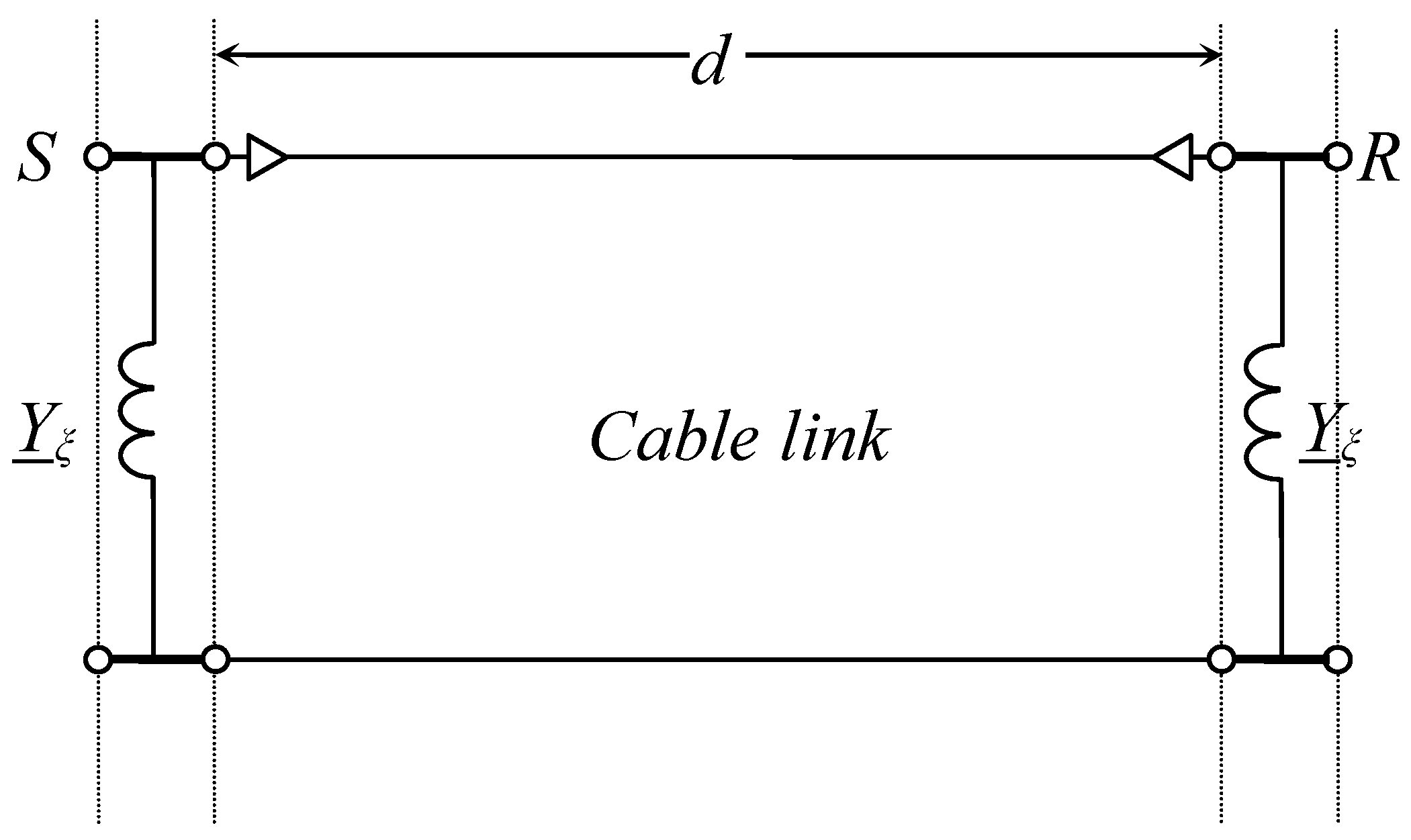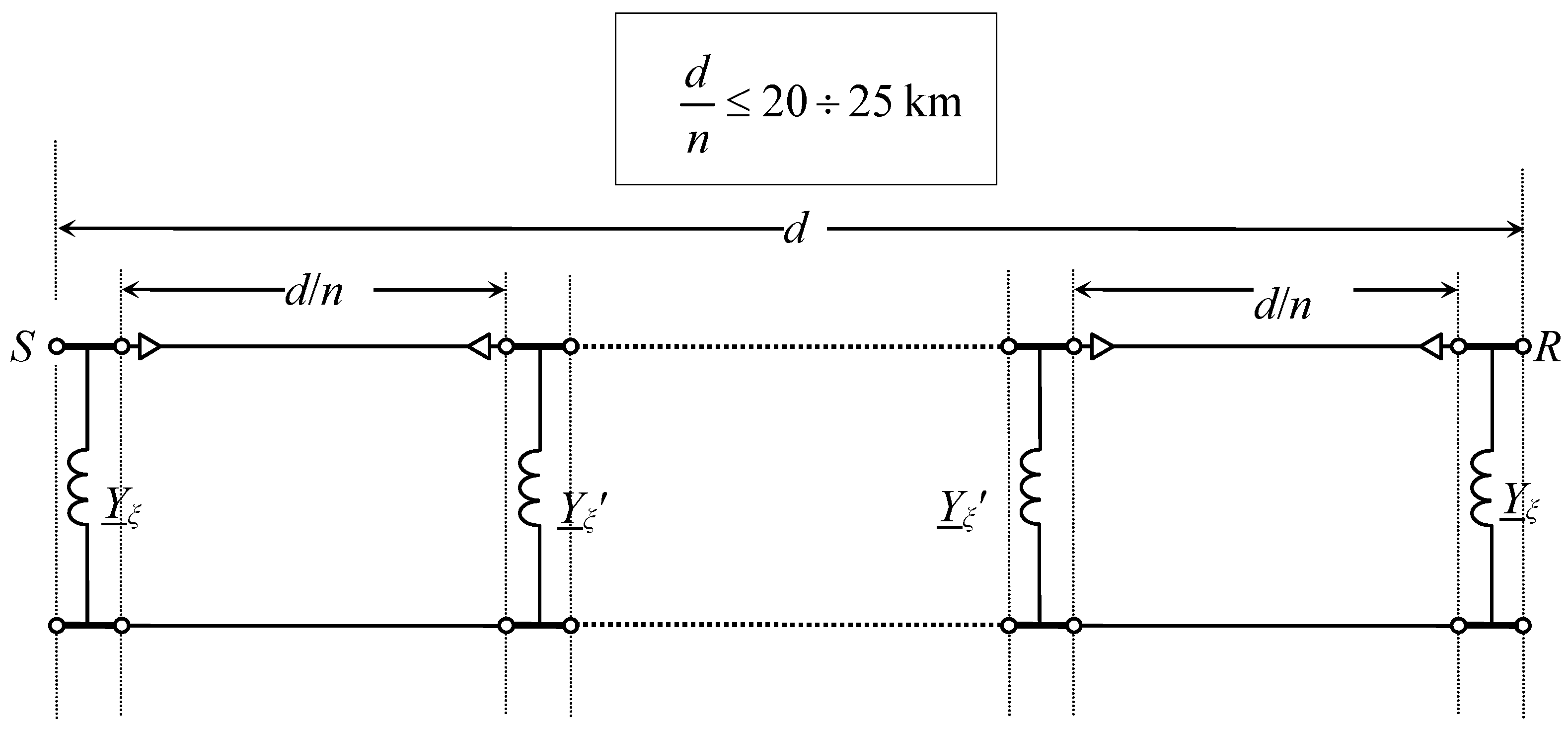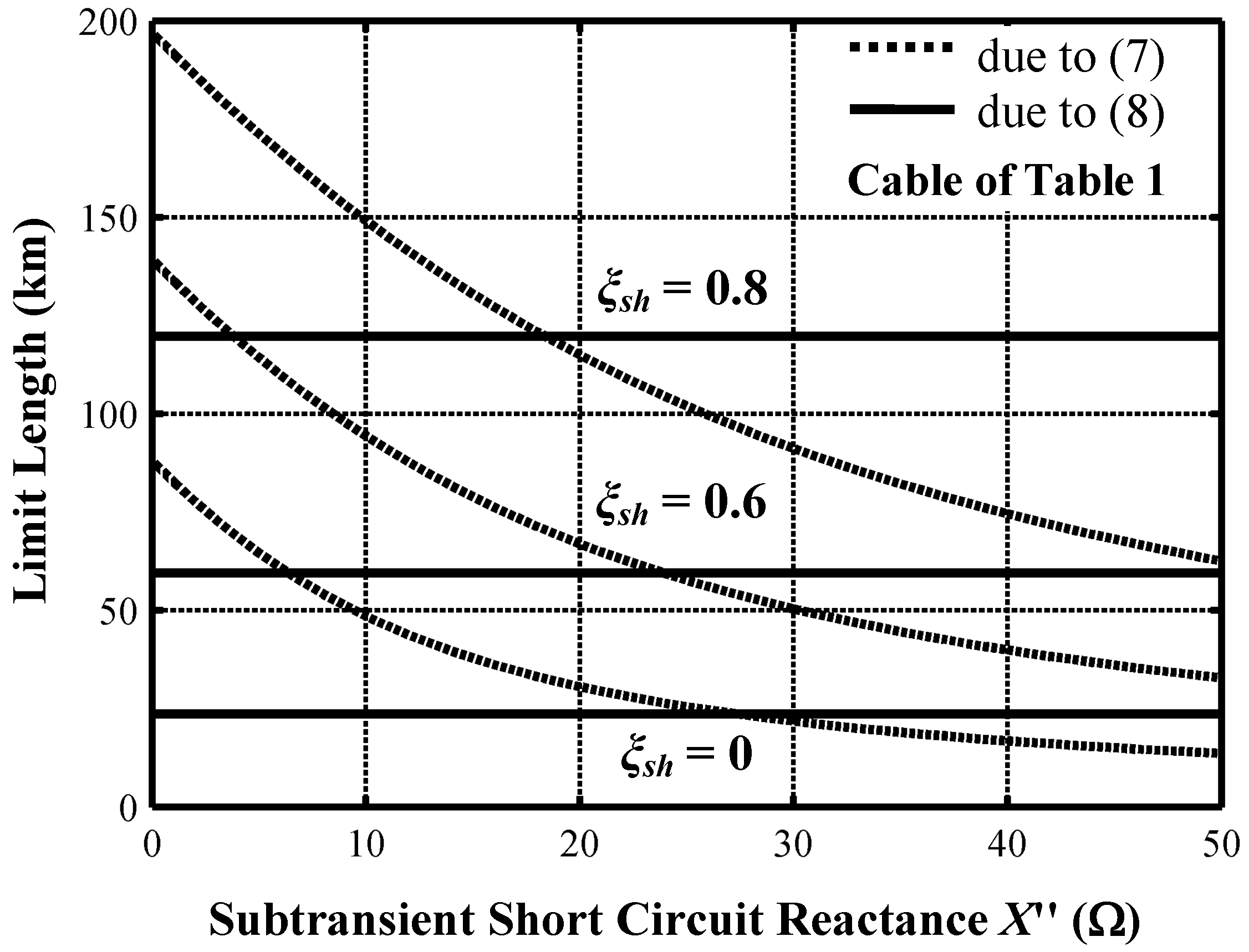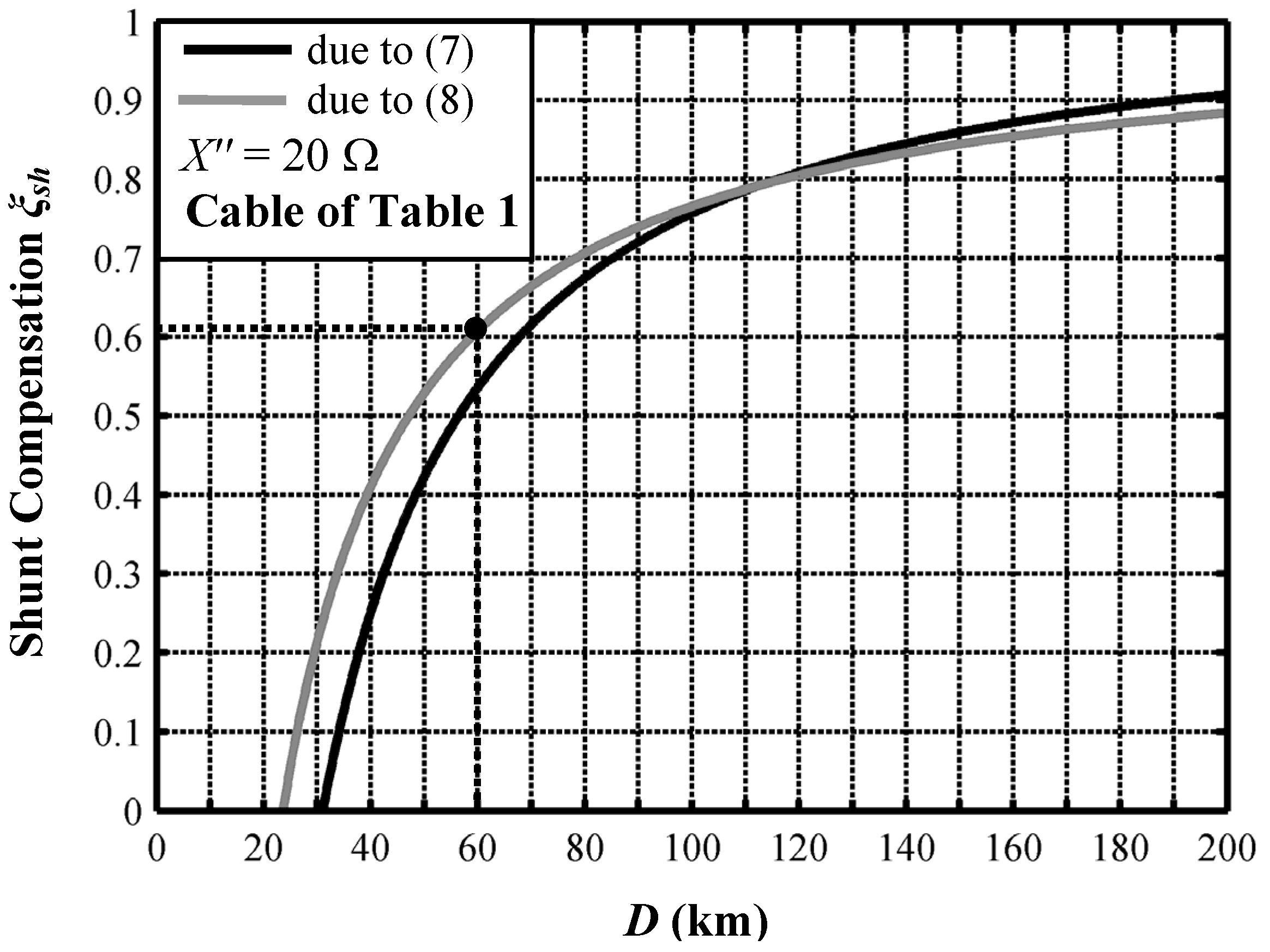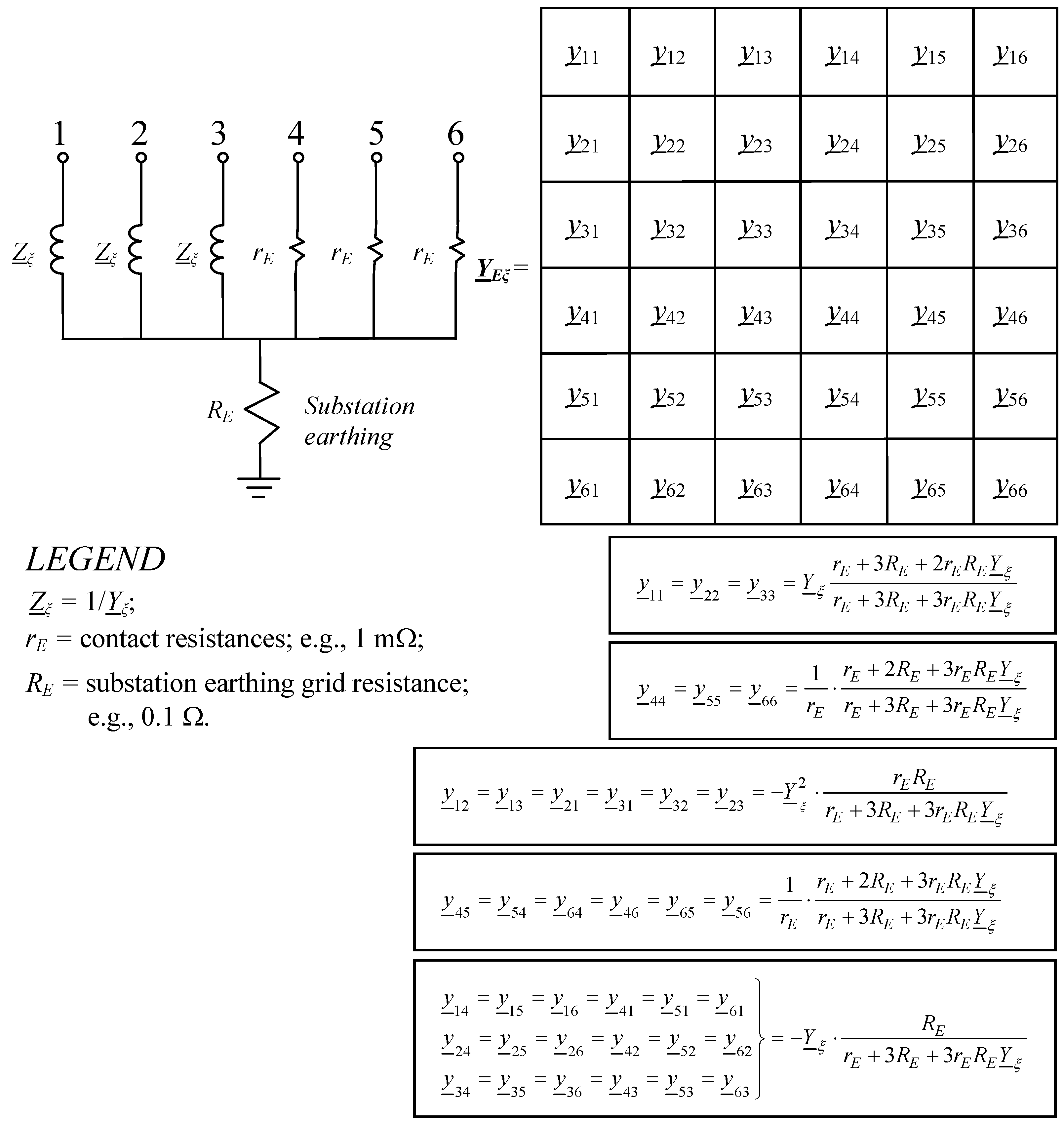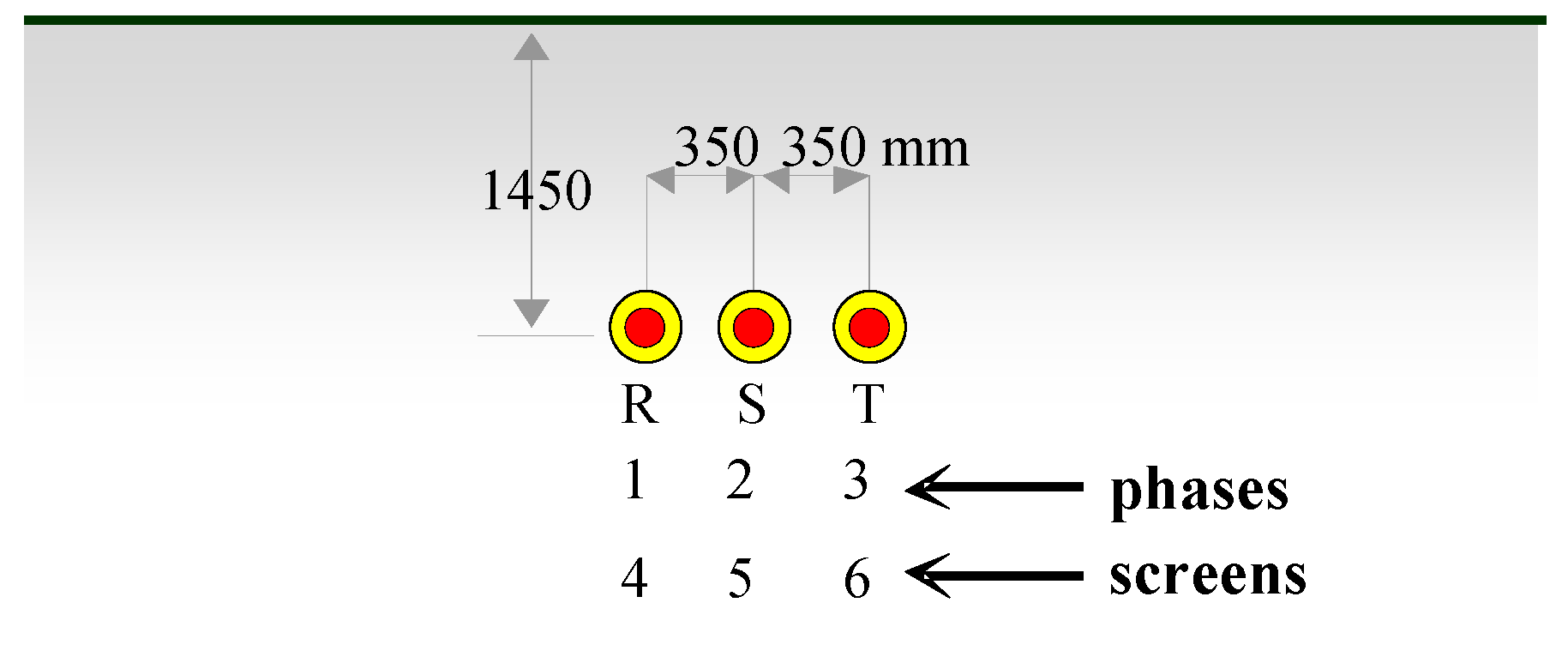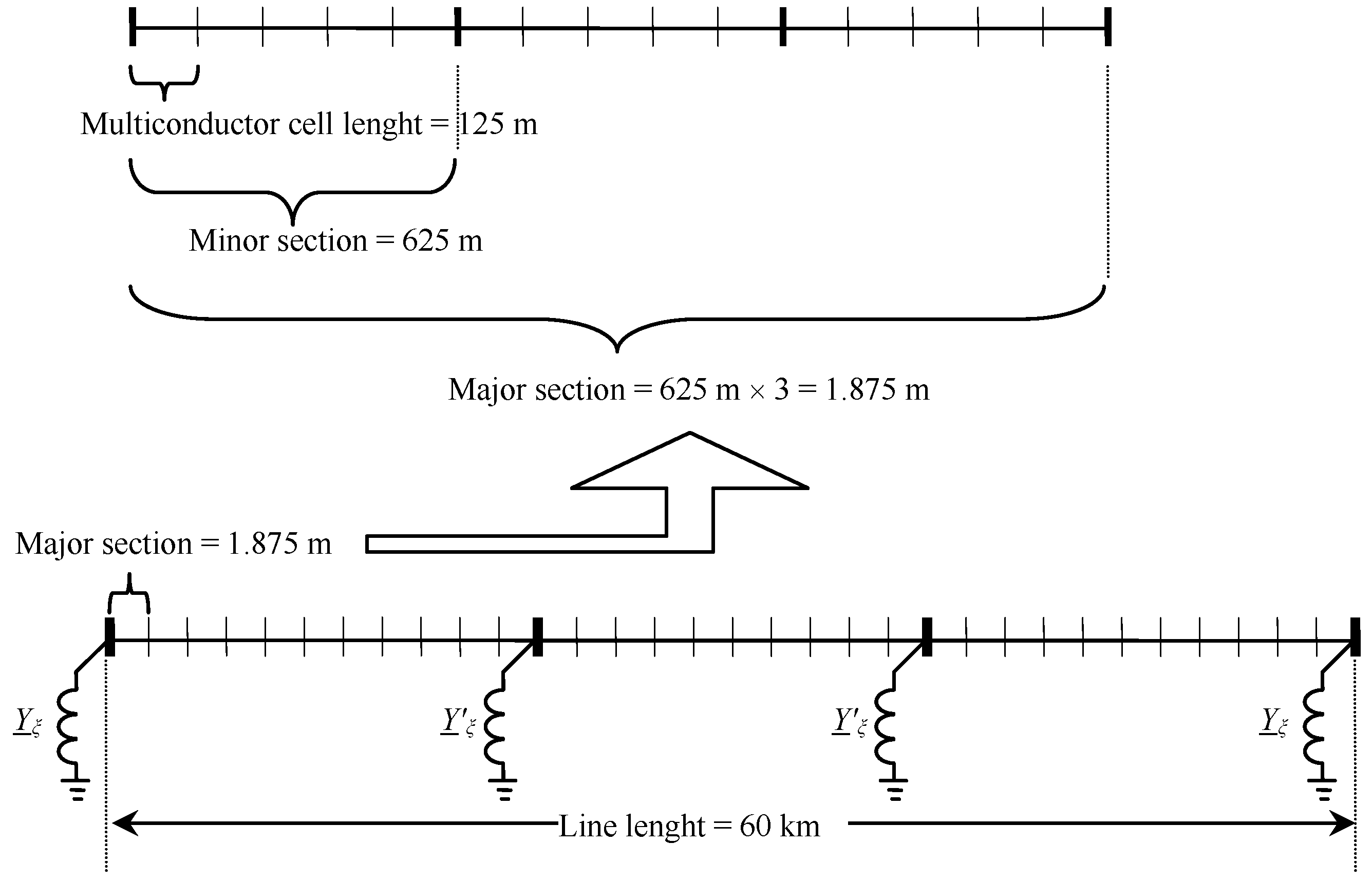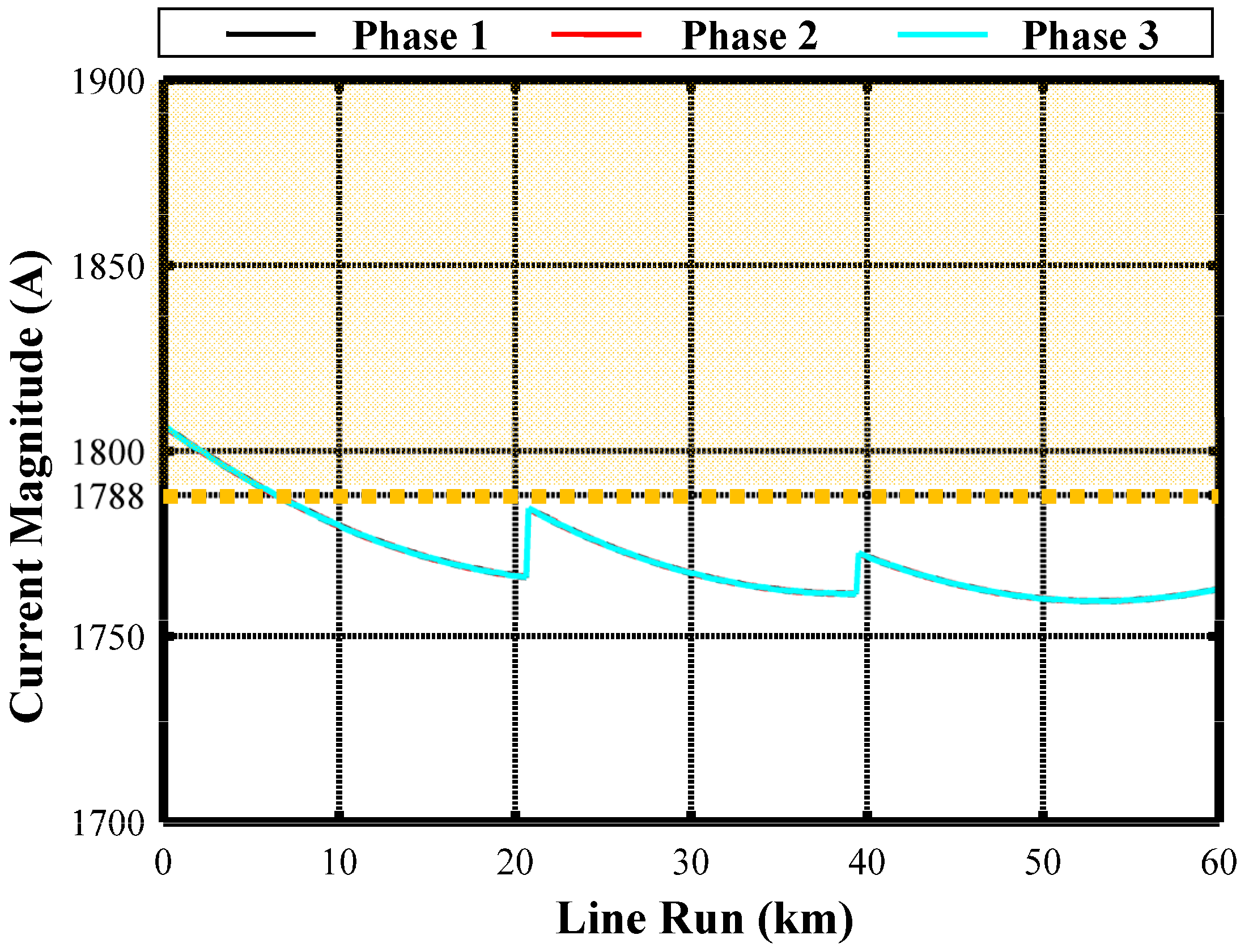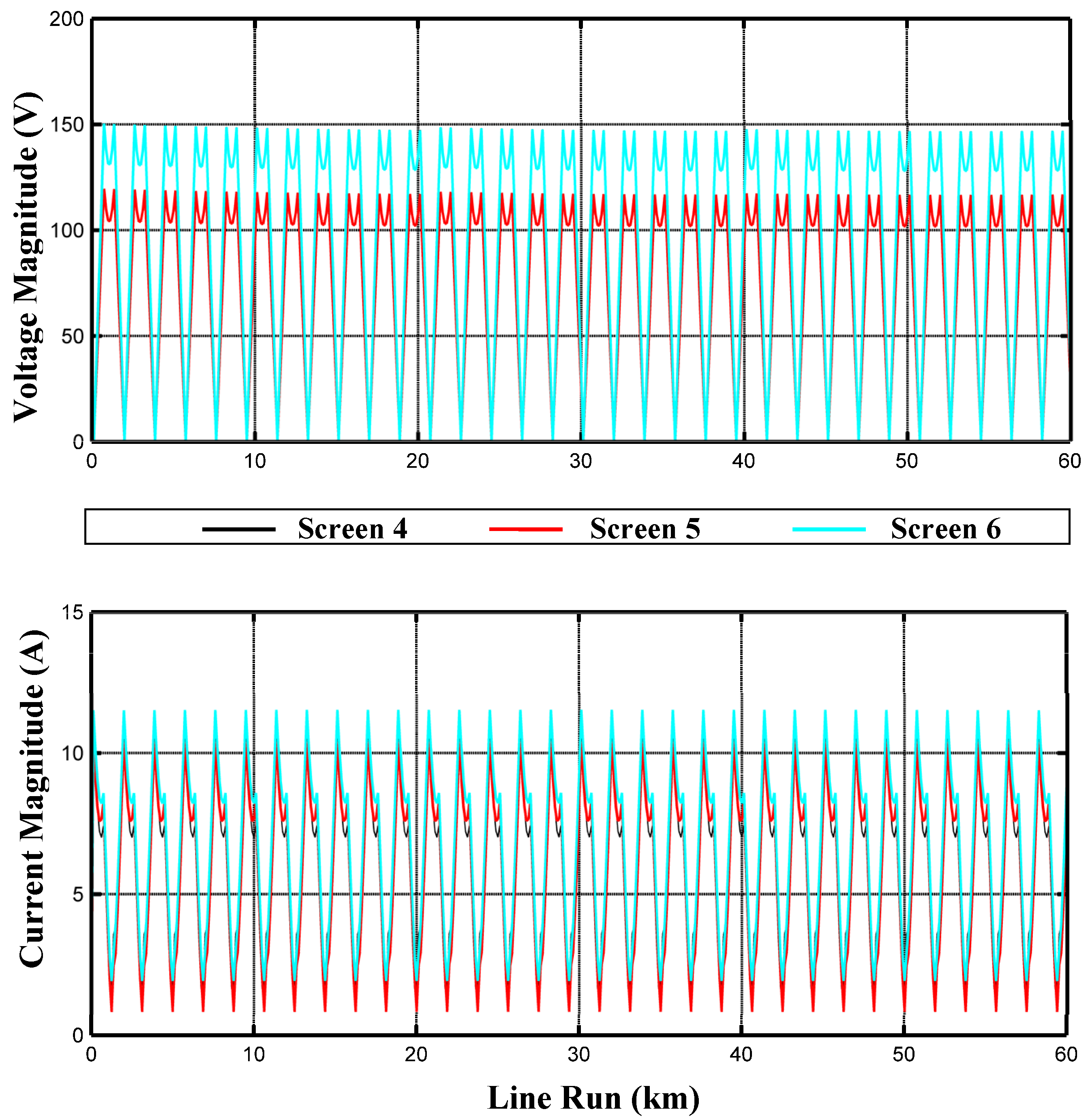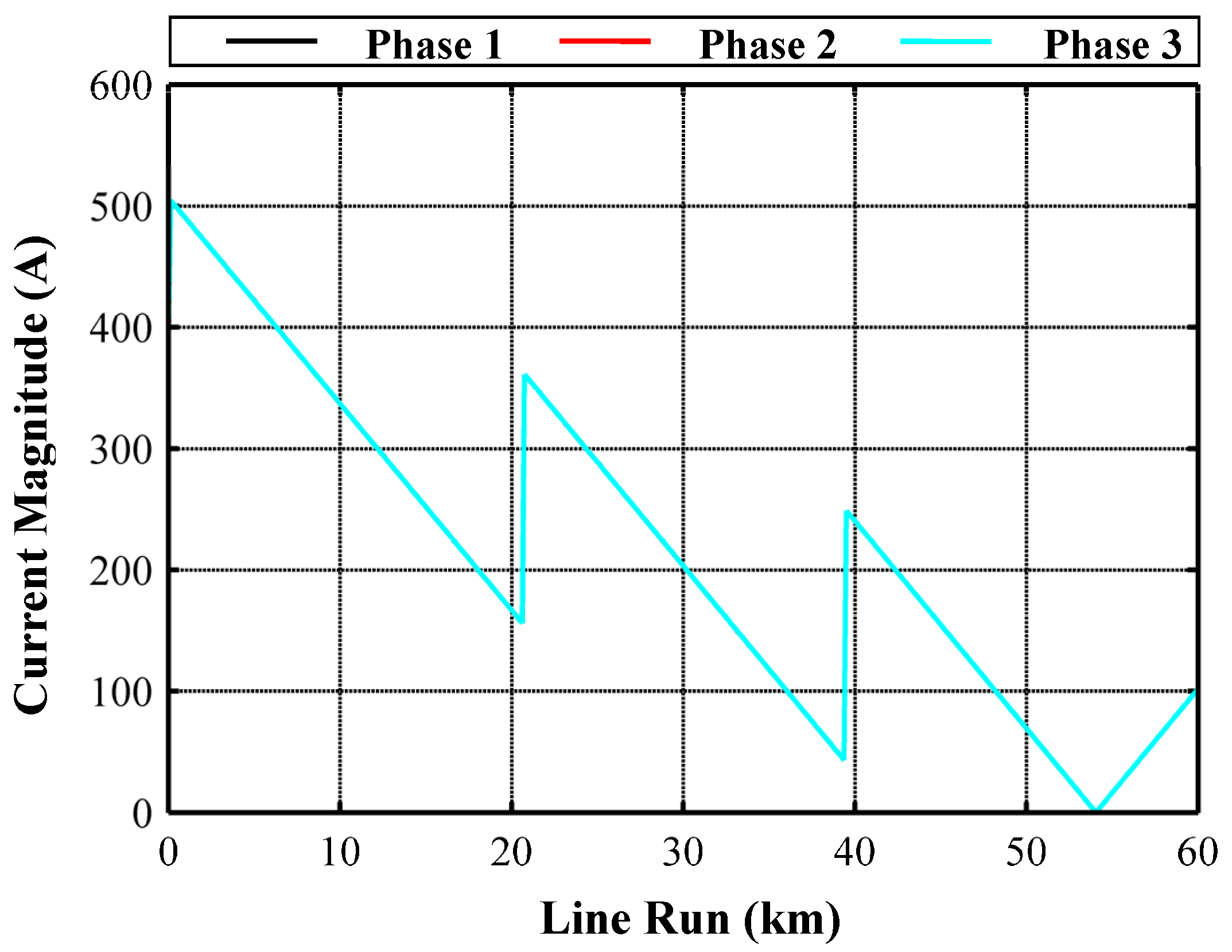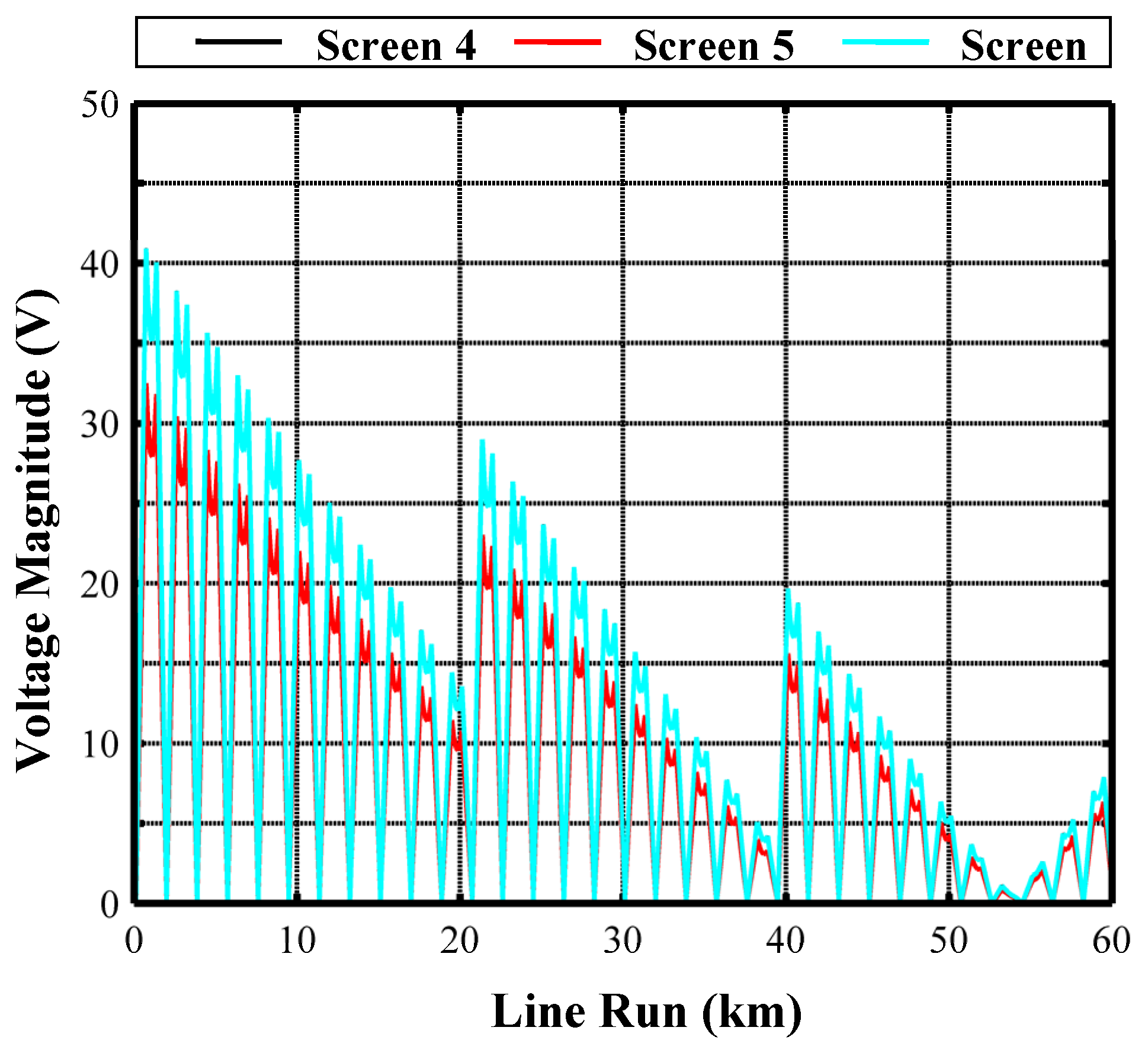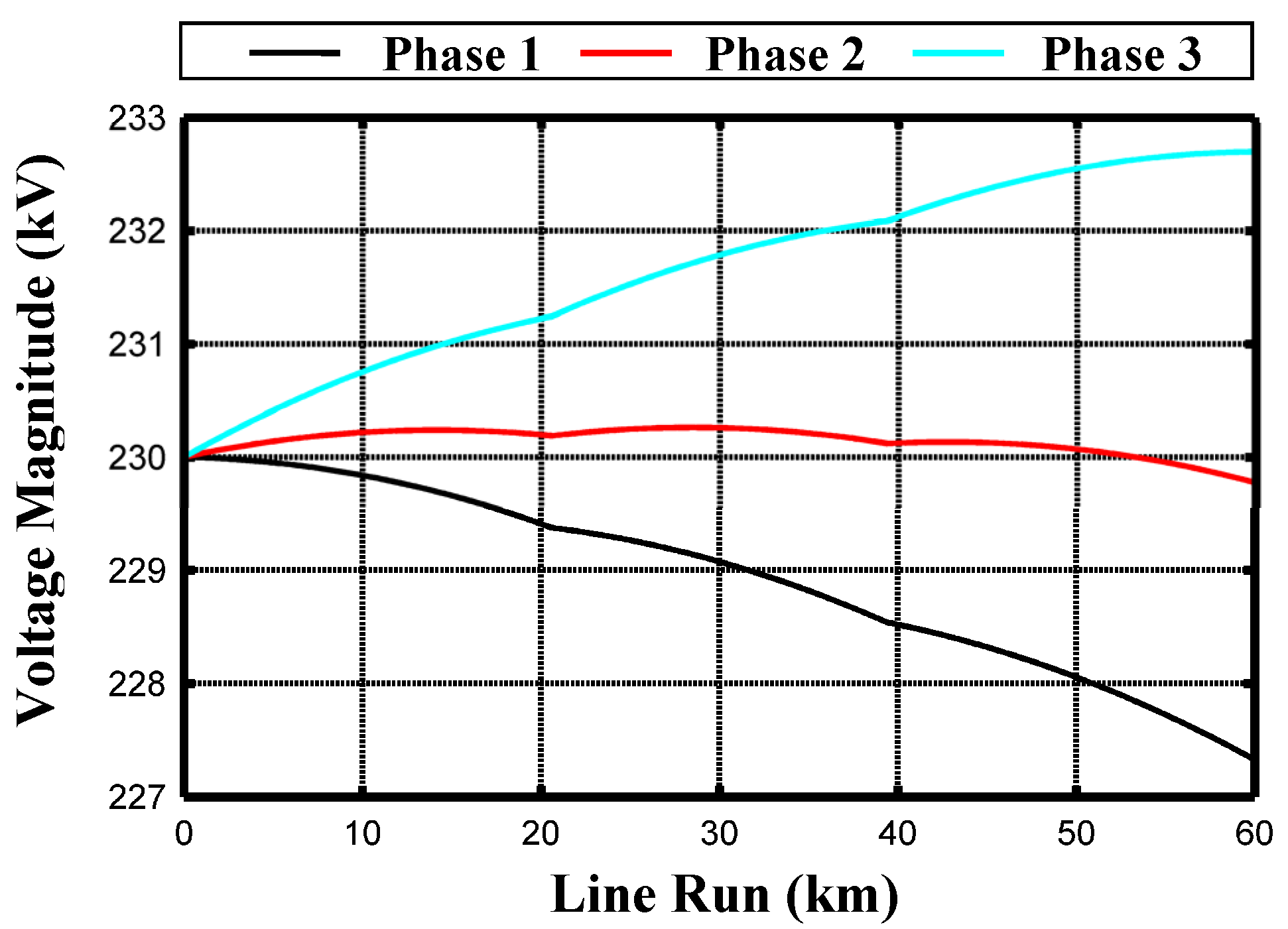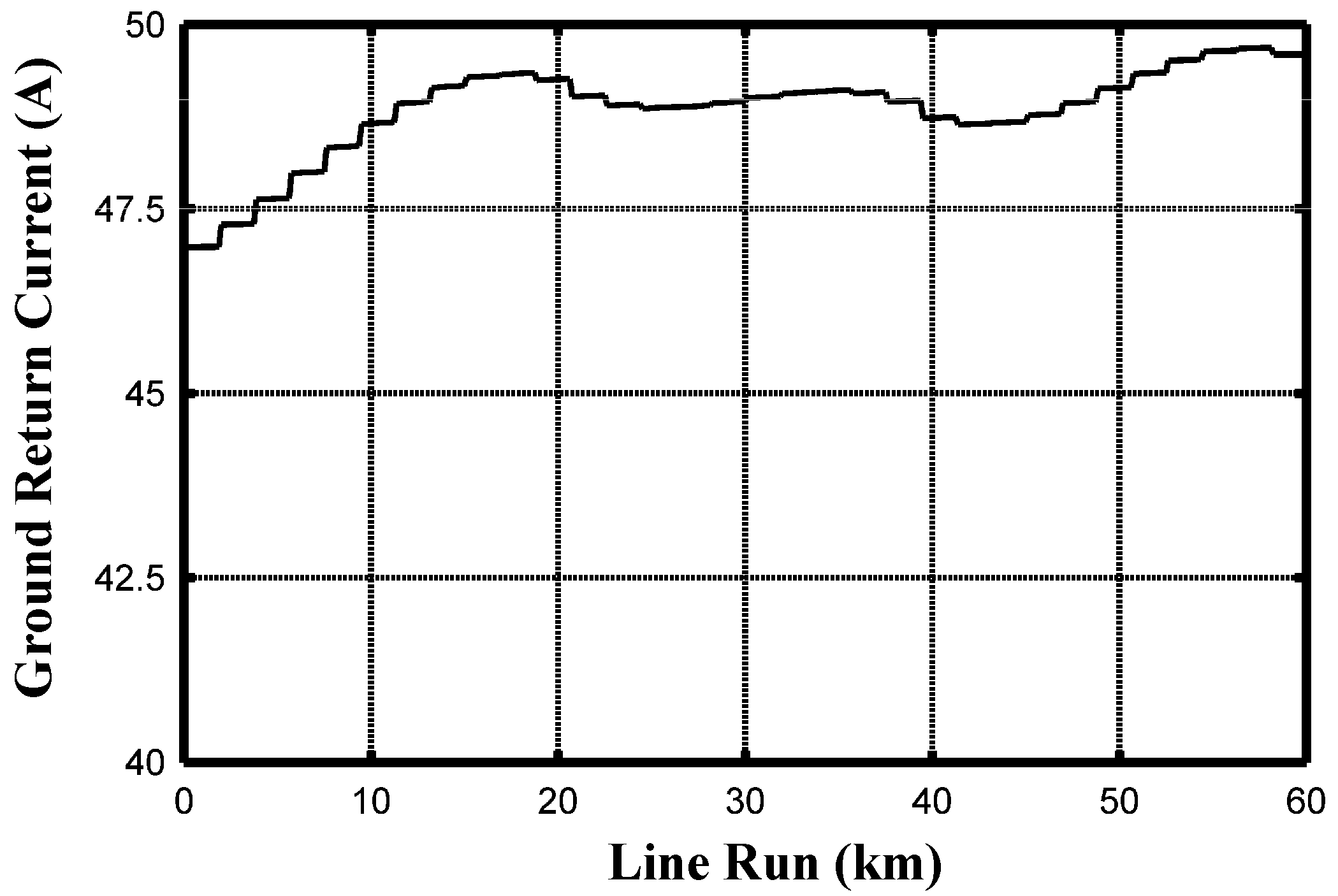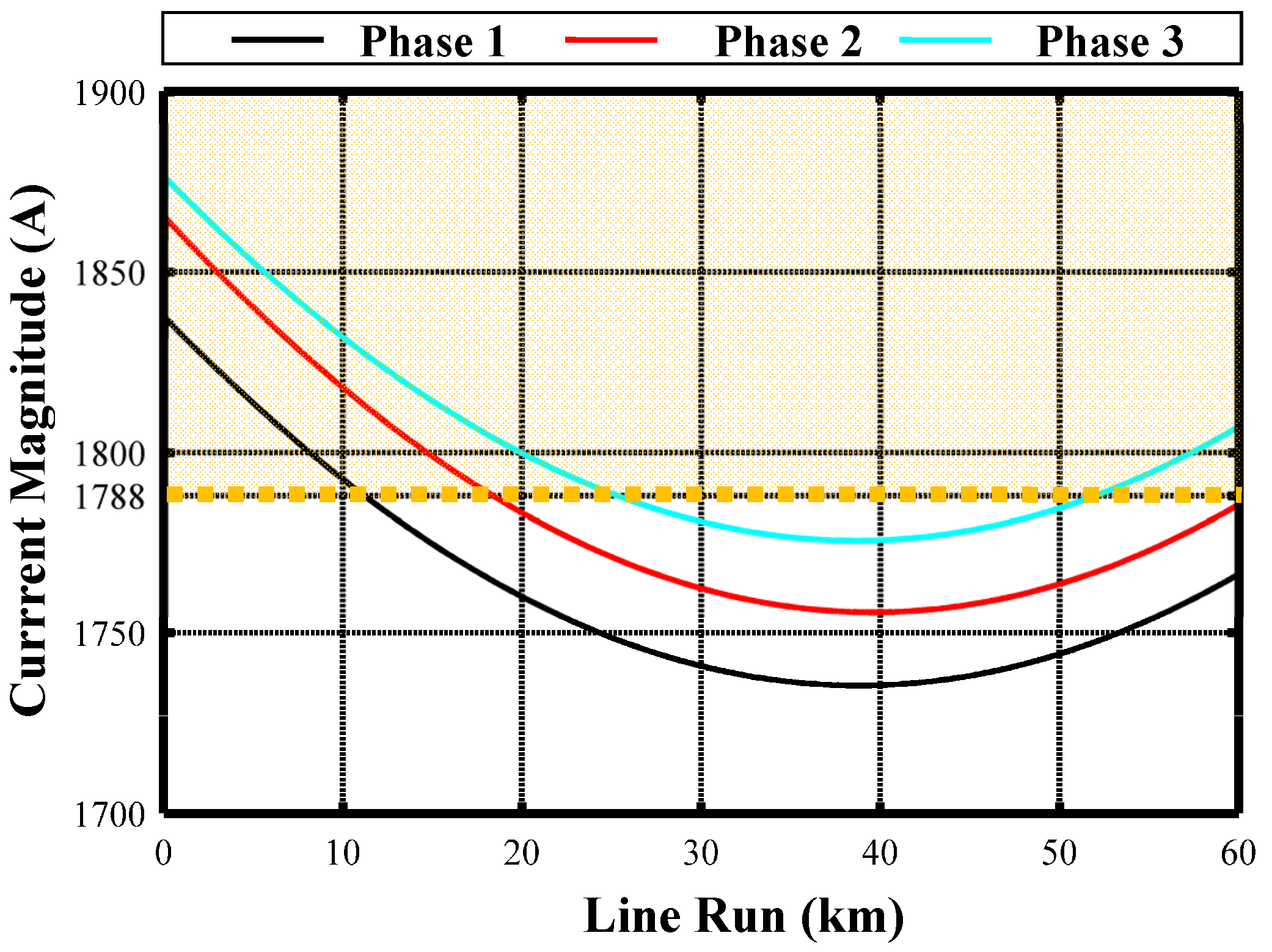2. Brief Recalls to Shunt Compensation Features
It is absolutely known that the kilometric cable capacitive susceptance has such a high value to determine (chiefly with great lengths, voltages and sections) in the network steady state and transient regimes that it could become very severe or even unacceptable, unless a suitable shunt compensation is adopted. The compensation of the uniformly distributed cable capacitive susceptance would theoretically require the insertion of uniformly distributed inductive susceptance. Since this is merely theoretical, the compensation is lumped. In order to give the reader some brief context, the lumped compensation can be performed both at the two ends (see
Figure 1) or also at intermediate locations (see
Figure 2). If the cable to be compensated has a length greater than
km it is suitable to also install shunt reactors at intermediate sections, provided with individuating
n sections within the limits shown in
Figure 2. The value
Yξ depends upon the shunt compensation degree, whose value can be computed by means of the criteria developed in the next subsection, which refer to the single-phase circuit. The value of
Yξ is obviously different depending upon these two different situations. In case of
Figure 1,
Yξ can be computed as in Equation (1):
where:
ξsh = shunt compensation degree;
c = UGC kilometric capacitance (F/km);
d = cable line length (km).
Figure 1.
Lumped shunt compensation at the two ends.
Figure 1.
Lumped shunt compensation at the two ends.
Figure 2.
Lumped shunt compensation at the ends and at intermediate locations.
Figure 2.
Lumped shunt compensation at the ends and at intermediate locations.
The computation of
Yξ and
Yξ' in case of lumped compensation also at intermediate locations (see
Figure 2) becomes:
The Determination of Shunt Compensation Degree by Means of Single-Phase Circuit
It is worth remembering that during network operation, very frequently recurring events of the greatest concern are the energization and de-energization of a no-load line since they are always necessary to prepare the operating structure of the grid. The simple sketch of
Figure 3 shows the switch-on of the circuit breaker in
S in order to energize the cable and serves as a first, not complete but meaningful approach devoted to highlight the limit conditions for line energisation at no-load. In a generic network, the power supply in
S can be modelled as an equivalent generator which is characterized by its electromotive force
Uo (assumed
Uo = 230 kV) and the short-circuit subtransient impedance
Z'' (for simplicity purely inductive
Z'' =
jX'').
Figure 3.
No load energization at port S.
Figure 3.
No load energization at port S.
The magnitude of no-load power frequency sub-transient voltage
at
R, due to the closing at
S, constitutes a reference (“indicial” value) to foresee the peak value of switching surges due to subsequent evolution of the phenomena and is completely defined through the following formulae:
being
A and
C the transmission hybrid parameters and
A/
C the impedance (almost completely capacitive) as seen from S with R at no-load. Equation (4) expresses the Ferranti effect. With regard to
Z'' =
jX'' evaluation, it is possible to refer to the subtransient impedance
Uo/
I''sc (from network studies): since the values of subtransient short circuit current
I''sc (three-phase at
S) in
EHV networks can be foreseen in the range 10
50 kA,
X'' corresponds to 23
4.6 Ω. In order to respect the standard switching levels (e.g., 1050 kV) with a conservative margin, it seems advisable that the phasor
U''oR does not exceed the magnitude
Um/
= 242.5 kV: such target can be reached by introducing in (5) a suitable compensation degree which suitably modifies the parameters
A and
C. In the hypothesis that, once the transient phenomena have extinguished, the voltage regulation restores again at port S the rated value
Uo = 230 kV, it is possible to compute:
which expresses the no-load steady state (almost entirely capacitive) current
INL (which the circuit breaker
b must interrupt in case of de-energization of the no-load cable): for this current the Standards on the Circuit Breaker (§ 4.107 of [
4]) suggest the limit value of 400 A. After all, both the following additional constraints must be fulfilled (by assigning a suitable compensation degree
ξsh):
The curves of
Figure 4 and
Figure 5 are computed for the cable of
Table 1: both show that the constraint (8) is almost always decisive for the determination of
ξsh, unless there is an agreement with the manufacturer for a circuit breaker with higher
INL.
Figure 5 clearly defines the values of shunt reactive compensation degree
ξsh which fulfills the relations (7) or (8): it shows which is the more limiting criterion as a function of the line length. It appears almost trivial to note that the considerations regarding the additional constraint of (7) must be performed also for the energization by the port
R, by introducing for the parameters
Uo and
X" suitable values in consideration of the supply grid linked to
R: the detection and the choice of the “best end switching” [
5] are mentioned by CEGB as effective experienced practices in network operations. Moreover, the cases where the steady state capacitive power absorbed by the cables (
QNL = 3
Uo INL) exceeds the ability of synchronous generators (dangerous self-excitation conditions), located in close proximity of the cable installation, must be avoided. In any case, it is advisable that the TSO, when planning a new link, performs both detailed power flows and network simulations.
Figure 4.
Limit lengths due to the constraints (7) and (8) for cable of
Table 1.
Figure 4.
Limit lengths due to the constraints (7) and (8) for cable of
Table 1.
Figure 5.
Reactive compensation degree as a function of cable length due to the constraints (7) and (8) for cable of
Table 1 and
X'' = 20 Ω.
Figure 5.
Reactive compensation degree as a function of cable length due to the constraints (7) and (8) for cable of
Table 1 and
X'' = 20 Ω.
Table 1.
EHV AC Cable under study.
Table 1.
EHV AC Cable under study.
| Cable cross-sectional area | mm2 | 2500 Cu |
Conductor diameter
(Milliken type with six sectors) | mm | 63.4 |
| XLPE insulation diameter | mm | 119.9 |
| Metallic screen diameter | mm | 130.1 Al |
| Screen cross-sectional area | mm2 | 500 |
| PE jacket diameter | mm | 141.7 |
| Total mass | kg/m | 37 |
3. Insertion of Shunt Reactors in the MCA
Once the model of CB UGC is completed in the MCA [1 ÷ 3], it is necessary to consider the presence of lumped shunt reactive compensation.
Figure 6.
Admittance matrix YEξ for shunt reactors and screen earthing.
Figure 6.
Admittance matrix YEξ for shunt reactors and screen earthing.
The insertion between phases 1, 2, 3 and the earth of three single-phase reactors (or three-phase ones with unchained magnetic flux) can be easily accounted for by means of the admittance matrix
YEξ to be overlapped in the right locations. There are two methods to compute the admittance matrix
YEξ; the former is a direct calculation by the inspection method as in
Figure 6. The latter is computing firstly the matrix
ZEξ (6 × 6), as shown in (9), where
Zξ = 1/
Yξ. Successively by matrix inversion, it is possible to obtain the admittance matrix
YEξ = (
ZEξ)
−1. The computation of the shunt susceptance
Yξ has been already presented in
Section 2.
Once the matrix
YEξ has been computed, it must be overlapped in the suitable positions (
i.e., only at the two ends or also at intermediate locations) on the general admittance matrix which accounts for the cable [
1,
2,
3].
4. Case Study
The abovementioned theory is applied to a directly buried (see
Figure 7,
Table 1 and
Table 2) shunt compensated long UGC (
d = 60 km) (as highlighted with a dot in
Figure 5, for
d = 60 km it yields
ξsh = 0.608). The UGC is cross-bonded (CB) with phase transpositions (PTs).
Table 2.
Data assumed in MCA.
Table 2.
Data assumed in MCA.
| Multiconductor cell length | | km | 0.125 |
| Cable drum (Minor section) | | km | 0.625 |
Cross-bonding section
Length (Major section) | | km | 1.875 |
| Substation earthing | RE | Ω | 0.1 |
| Earth resistivity | ρsoil | Ω m | 100 |
| Cross-bonded box resistance | R | Ω | 10 |
| Screen resistance at 78.2 °C (50 Hz) | rsh | mΩ/km | 70.0 |
| Link resistance | rE | mΩ | 1 |
| Shunt compensation degree | ξsh | | 0.608 |
| Number of shunt compensation stations | | | 4 (or 2) |
| Ampacity | | A | 1788 |
| Load at receiving-end | | MW + jMvar | 1214 + j0 |
Figure 7.
Single-circuit CB UGC.
Figure 7.
Single-circuit CB UGC.
The whole multiconductor system is shown in
Figure 8, which helps visualizing both the cable subdivision in elementary cells (with indication of minor and major sections) and the lumped shunt compensation locations. In this case, the minor sections have all equal lengths but this method also suits very well the case of different lengths (as in the real installations).
Figure 8.
Subdivision of the CB single-circuit cable line with indication of lumped shunt compensation locations.
Figure 8.
Subdivision of the CB single-circuit cable line with indication of lumped shunt compensation locations.
Figure 9 shows the phase current magnitudes along the cable: they are in whole accordance with those obtained by means of the single-circuit positive sequence analysis [
3]. Obviously, the multiconductor analysis gives a higher accuracy of the system knowledge.
Figure 9 shows a light exceeding of the ampacity (grey zone) in the first kilometres, but it is not problematic when consideration is given to the natural fluctuations of the line operation.
Figure 9.
Phase current magnitudes along the compensated single-circuit cable, in CB with PTs.
Figure 9.
Phase current magnitudes along the compensated single-circuit cable, in CB with PTs.
Figure 10 shows the phase voltage magnitudes which are in whole accordance with those obtained by means of single-circuit positive sequence analysis: nevertheless,
Figure 10 shows the great accuracy and detail of MCA and a negligible voltage asymmetry.
Figure 10.
Phase voltage magnitudes along the compensated single-circuit cable in CB with PTs.
Figure 10.
Phase voltage magnitudes along the compensated single-circuit cable in CB with PTs.
One of the great possibilities offered by the multiconductor analysis is the knowledge of the screen electric behaviours.
Figure 11 shows the screen voltage and current magnitudes along the cable.
Figure 11.
Screen voltage and current magnitudes along the compensated single-circuit cable in CB with PTs.
Figure 11.
Screen voltage and current magnitudes along the compensated single-circuit cable in CB with PTs.
The screen currents of induced nature are extremely low so demonstrating the effectiveness of CB arrangement: the residue currents are those of capacitive nature. The no-load steady-state regime has also been investigated:
Figure 12 shows the phase current magnitudes along UGC. Since the use of PTs, the behaviours of the three phases are very similar to those derived by means of single-phase positive sequence circuit: therefore, they are visible as a unique curve. Moreover in
Figure 13 the screen voltage magnitudes are shown: the induced voltages in the screens are strictly depended upon the inducing phase currents.
Figure 12.
Phase current magnitudes along the compensated UGC in CB with PTs at no-load.
Figure 12.
Phase current magnitudes along the compensated UGC in CB with PTs at no-load.
Figure 13.
Screen voltage magnitudes along the compensated single-circuit cable in CB with PTs at no-load.
Figure 13.
Screen voltage magnitudes along the compensated single-circuit cable in CB with PTs at no-load.
All the abovementioned situations can be studied also with a single-phase positive sequence model even if the MCA allows a deeper knowledge of the power system. In the following more asymmetrical situations are shown. In fact, as well-known, the CB performed without PTs (many TSOs do not perform phase transpositions) has a higher level of asymmetry so that, in these cases, the MCA becomes an unavoidable tool for engineering investigations.
Figure 14.
Phase current magnitudes along the compensated single-circuit cable in CB without PTs.
Figure 14.
Phase current magnitudes along the compensated single-circuit cable in CB without PTs.
Figure 15.
Phase voltage magnitudes along the compensated single-circuit cable in CB without PTs.
Figure 15.
Phase voltage magnitudes along the compensated single-circuit cable in CB without PTs.
They represent phase current and voltage magnitudes, respectively, for CB performed without PTs. The behaviours of the three phases 1, 2, 3 are rather different and in the case of
Figure 14 the ampacity limit is exceeded by both phase 2 and 3. Another important feature of CB without PTs is the fact that it implies a ground return current, as
Figure 16 shows. It is worth noting that this current is always present in steady-state operation so that possible electromagnetic interferences could arise with nearby parallel metallic systems. The shunt compensation only at the two ends is possible but it gives wider stretches of ampacity exceeding as
Figure 17 clearly shows. In this case, the ampacity is exceeded (grey zone) by all the three phases and for a long stretch of UGC length. Moreover, power losses (average value equal to 135 kW/km) are higher than those due to the shunt compensation also at intermediate locations (average value equal to 133 kW/km).
Figure 16.
Ground return current magnitude for CB UGC without PTs.
Figure 16.
Ground return current magnitude for CB UGC without PTs.
Figure 17.
Phase current magnitudes along the compensated single-circuit cable in CB without PTs and compensated only at the two ends (as in
Figure 1).
Figure 17.
Phase current magnitudes along the compensated single-circuit cable in CB without PTs and compensated only at the two ends (as in
Figure 1).
